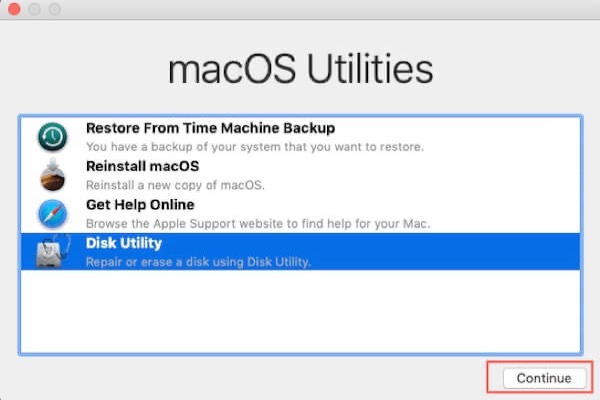Many people are looking for good third-party disk management tools. But compared with those paid software, Disk Utility is more reliable as it's built inside the Mac operating system. In addition to normal disk management, it enables you to boot Mac into Disk Utility, so you can open Disk Utility on Mac startup when the Mac won't start.
Usually, only 3 steps are required to access Disk Utility Mac Recovery Mode.
- 1. Turn off your Mac.
- 2. Restart your Mac and boot it to macOS Recovery mode.
- 3. Select Disk Utility on the macOS Utilities window.
Let's dive into the details!
How to boot Mac into Disk Utility?
Based on if you can turn on and boot your Mac, there are mainly two ways to access Disk Utility.
Open Disk Utility on a working Mac
It's relatively easy to access Disk Utility after Mac boots up. You can either find this utility via Spotlight or access it from Finder > Applications > Utilities > Disk Utility. Then, you can open Disk Utility and manage your disks.
Boot Mac into Disk Utility Recovery Mode
Another situation in which you want to access Disk Utility is when the Mac is not turning on. The symptoms vary from a flashing folder at Mac startup to a frozen loading screen with or without an Apple logo. Then, you need to check if the boot drive is corrupted and fix related issues with Disk Utility.
So, follow this guide to open Disk Utility on Mac at startup and boot the problematic Mac again.
- Make sure your Mac has completely turned off. If your Mac is frozen, you can hold the power button until the Mac shuts down.
- Boot your Mac into macOS Recovery Mode, follow the correct steps to boot the Intel Mac or Apple Silicon Mac into macOS Recovery Mode.
- You'll see a macOS Utilities or Mac OS X Utilities window, which depends on your Mac operating system.
- Select Disk Utility to repair or erase a disk.
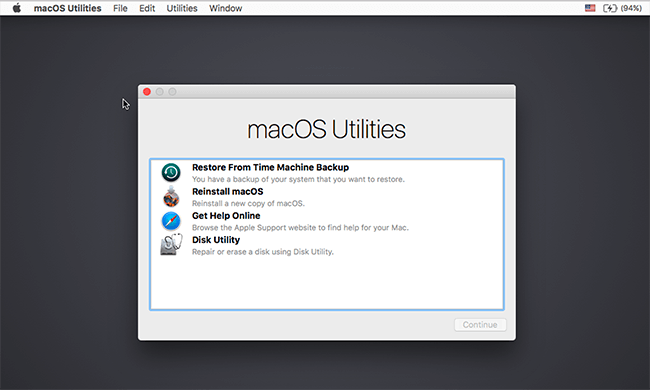
How to repair the startup disk in Disk Utility in Recovery Mode?
If you doubt that there are some errors inside the startup disk, you can run First Aid to check and repair the disk. Here is how to do this.
- In the Disk Utility window, select your boot drive and click on First Aid on the top.
- Choose the Run button to confirm that you need to repair this drive.
- After First Aid on the startup drive, your Mac should boot as normal.
If First Aid fails, then the file system of the startup disk might be corrupted. You need to fix it by reformatting the corrupted internal hard drive or SSD, which will replace the problematic file system with an intact one.
Despite this, you should know that reformatting will return you a blank and empty disk. That's to say, you'll lose all your data on the startup disk if you have never backed up your files. Fortunately, Mac data recovery software like iBoysoft Data Recovery for Mac now is available to recover data even when the Mac is not turning on.
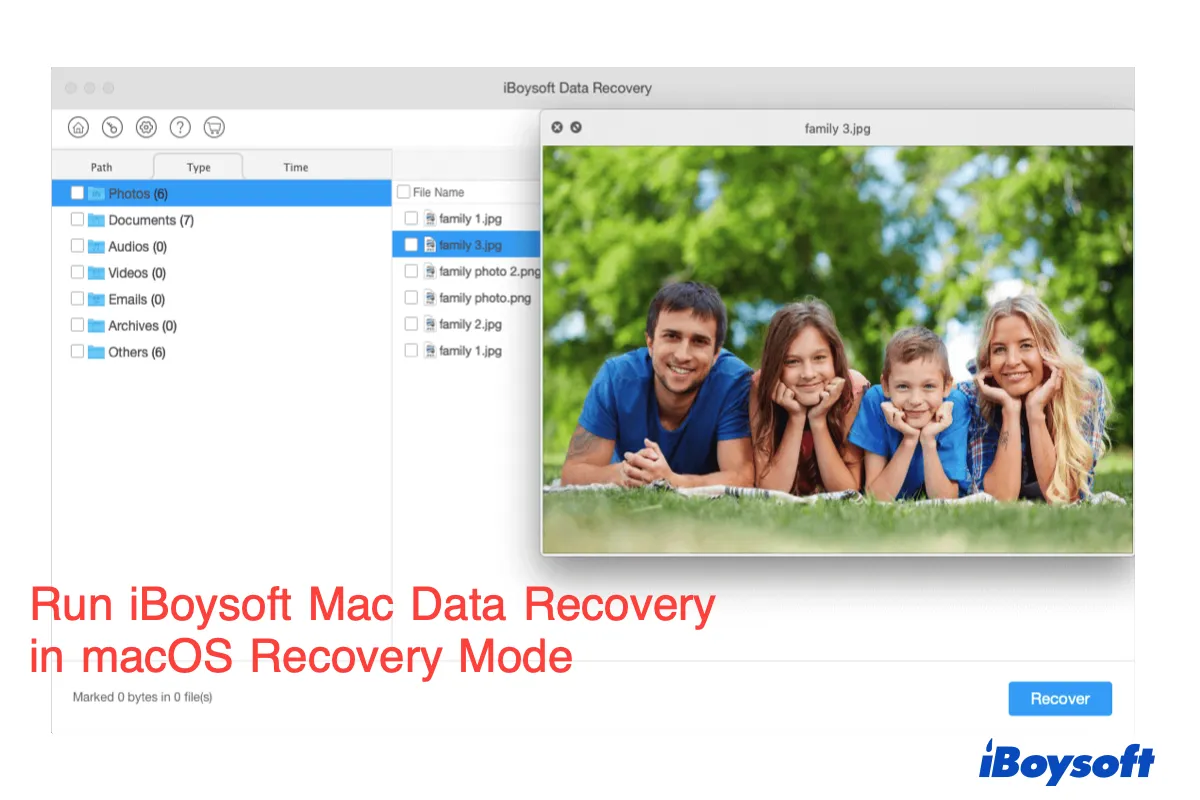
How to run iBoysoft Data Recovery in macOS Recovery Mode?
Here is a guide to recover and rescue files from MacBook Pro, Mac mini, MacBook Air, and iMac when it is not turning on. Read more >>
In addition to recovering data from an unbootable Mac, iBoysoft Data Recovery for Mac also helps on a working Mac when you need to recover deleted files, perform SSD data recovery on Mac, and so forth. Free download and install this professional data recovery software to rescue your data if necessary!
How to reformat the startup disk in Disk Utility in Recovery Mode?
After you get all files off the crashed Mac, you can continue reformatting the failed startup disk with Disk Utility. Let's get it underway.
- You need to access Disk Utility by booting the Mac into macOS Recovery mode as you did before.
- Find Disk Utility in Mac OS X Utilities (or macOS Utilities) and open it.
- Select the failed Mac hard drive which usually is called Macintosh HD or Apple SSD. Then, click on the Erase button.
- In the pop-up window, name it Macintosh HD, choose a Format, and select a scheme for the drive.
- Click on Erase to confirm this operation.
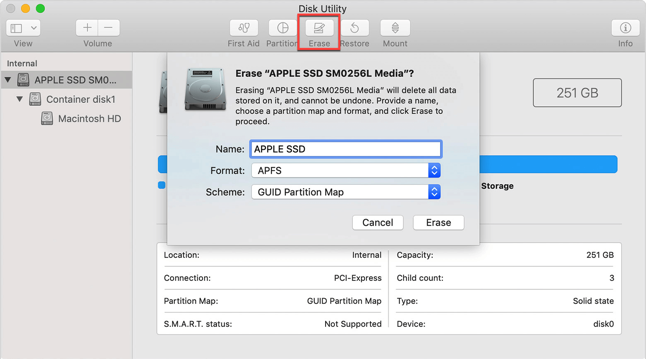
After reformatting, Disk Utility has done its job. Then, you can go back to macOS Utilities and choose reinstall macOS or Mac OS X so that you can boot from this drive again.
About Mac's Disk Utility
Disk Utility is a system utility for performing disk and disk volume-related tasks on macOS and Mac OS X systems. With this easy-to-use program, you can perform tasks as the following:
- Mount, unmount and eject connected hard drives including SSDs.
- Create, resize, and delete partitions by allocating space to storage devices.
- Erase and format disks with multiple file system options supported.
- Combine multiple hard disks into a RAID set for better performance and reliability with increased storage capacity.
- Create, backup, convert, compress, encrypt, and restore disk images.
- Verify a disk's integrity and repair it with First Aid if the disk is damaged or corrupted.
Some other features are dismissed along with the development of Mac operating systems. For example, you can't repair disk permissions in Disk Utility anymore in macOS. Even so, it's undeniable that what Disk Utility can do now is still good enough in many ways.
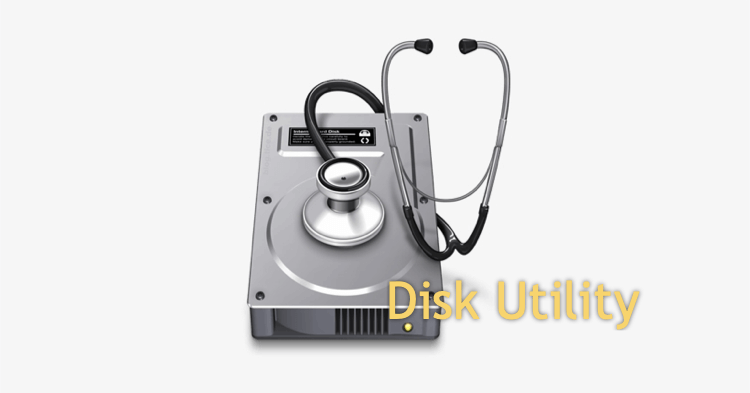
Of course, you can perform many disk-related tasks with Disk Utility, simple and easy. But the risk of using Disk Utility is also an important part that you should know. If you don't use Disk Utility in the right way, you could get into trouble. Usually, there are three possible problems.
1. Data loss
Your documents, emails, photos, music, movies, etc. could get lost after your misoperation. If you don't back up the data, you'll lose files after you erase a hard drive, delete an APFS volume, or format a partition.
So, be careful with these options mentioned above and always back files up.
2. Disk corruption
Except for files being deleted, what's worse is that the hard drive itself is corrupted. For example, you should always choose the Eject button before removing an external hard drive. If you don't, the risk of disk corruption is increased. The next time you want to access the external hard drive on a Mac, you could receive an error message like "The disk you inserted was not readable by this computer."
3. System crashes
The worst case is when the Mac keeps crashing after you delete one of the key partitions in the startup disk. For instance, when you add a new partition to the internal SSD, some core partitions could be deleted by the system rebuilding the partition table.
For Macs whose startup drive is formatted with HFS+, the MacBook won't turn on after a wrong deletion of disk0s1 or the EFI boot partition. Similar things happen to APFS formatted boot drives as well, especially for Macs that have Apple's T2 security chip. If you accidentally removed volumes like Recovery and VM, MacBook or Mac mini introduced after 2018 will have boot problems. It's because the T2 security chip fails to verify the integrity of the boot process.
So, if you see unknown volumes listed under the startup disk, always check through this volume before you finally remove it. Also, you should pay more attention when you want to re-partition the internal hard drive.
Sum up
As you can see, Disk Utility does help a lot in managing hard drives and SSDs on Mac. You can even boot to Disk Utility in macOS Recovery mode and fix Mac boot problems and startup disk errors, which is impossible for most third-party programs. It also can be accessed in Terminal if you are a command-line lover. Now, you can make use of Disk Utility whenever you encounter a disk-related issue.
